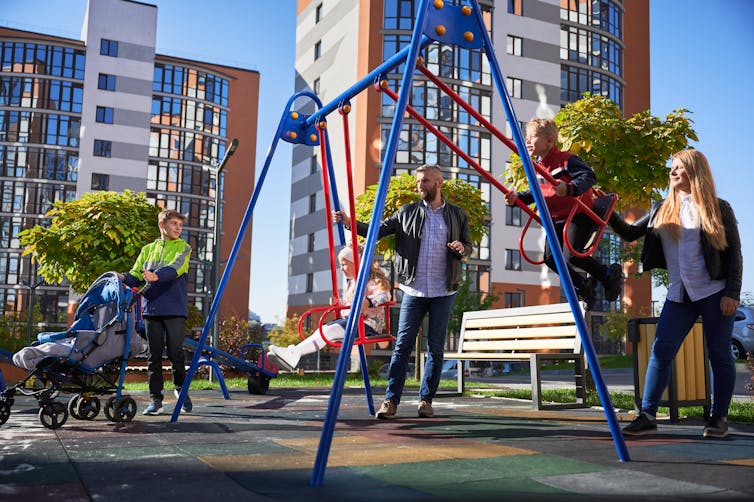Wanted: family-friendly apartments. But what do families want from apartments?
Despite a surge in development, most apartments are one or two bedrooms and not family-friendly.
Despite a surge in development, most apartments are one or two bedrooms and not family-friendly.

The family-friendly apartment is an idea whose time has come. In the Liverpool CBD in Sydney, for example, half the apartments are occupied by families with children, our found. This is .
The high proportion of families living in apartments in town centres like Liverpool is often overlooked when situated within suburbs dominated by detached, lower-density dwellings.
The proportion of families living in apartments challenges many . Apartments are often seen as āstepping stonesā for singles and couples on their way to detached houses, or a convenient lifestyle option for downsizers and empty-nesters.
The families in our study prioritise large, centrally located apartments over detached car-dependent dwellings. However, we found thereās a lack of larger apartments designed to meet familiesā needs.
The families we interviewed reported many benefits to apartment living. They valued being close to work, schools and leisure facilities, with easy walking access to diverse shops and services.
These preferences reflect the marketed benefits of compact living. And our research shows a range of households, including families with children, recognise these benefits. This points to a more fundamental shift in housing demand.

Families value the easy access to services and amenities that living in CBD apartments offers. Photo: Shutterstock.
Among our study participants, the birth of a new child did not lead to a detached car-dependent home. Instead, it triggered a search for a larger apartment in the town centre.
These trends are only partly about choice. Participants acknowledged that a detached home would be more spacious but it would also mean they faced the added costs of buying and running a second car.
On balance, participants felt the CBD was the ābest placeā to live. Their priority was finding suitable high-rise homes within walking distance of schools, shops, public transport and community services ā including libraries, health centres and parks.
However, when we compared Liverpool CBD familiesā preferences with housing supply, we found an overproduction of one- and two-bedroom apartments. These account for most of the increase in apartment numbers over the past decade, as the table below shows.
Despite half of all apartment occupiers having children, the proportion of family-sized apartments hasnāt increased. In recent years, it actually fell.
Just over 15% of the high-rise housing stock in the CBD comprised three bedrooms or more at the 2011 and 2016 censuses. By 2021, it had fallen below 14%.
Without planning controls, the supply of large, family-friendly apartments is unlikely to increase. Developers, juggling their own material and credit costs, will always seek to maximise the number of dwellings they can build on their lots.
The requires 10% of the stock to be three-bedroom apartments. This is on par with the rest of Sydney. An exception is the , which has experimented with 20% in development corridors. Increased supply without design and quality controls can nonetheless exacerbate the tensions of raising a family in an apartment.
Real estate advertising for apartments emphasises skyline views, open-plan layouts and private balconies. But it is less glamorous aspects ā insulation, space and storage ā that can be crucial for families to live well in a high-rise home.
Good family-friendly design includes space for children to sleep, play and study, and adequate storage for prams and the belongings of larger households. is also needed to reduce tensions over childrenās noise.
All these features are critical for higher-density dwellings to cater properly for this growing demographic.
Construction quality is also important. A of federal and New South Wales parliamentary inquiries reveals the impacts of public policies of deregulation, self-certification and performance-based construction. The effect has been to shield cost-cutting by developers and construction companies while transferring risks to consumers.
While state governments experiment with , consumers , both financial and emotional, of cut-price construction.
Societies in which a shift to higher-density living is part of family life must strike a reasonable balance between quality, affordability and apartment size. Yet these goals seem to be at odds with the reconfiguration of housing in Australia as an investment vehicle.
The protection of owned homes from capital gains tax and lavish subsidies for property investors have led to gains in the value of housing assets . This sets the scene for finance and construction industries to capitalise on investor-driven demand rather than diverse familiesā needs.
Meeting demand for high-rise housing in town centres requires a triple-barrelled approach. Construction quality, planning control and reconfigured financial incentives are all needed to encourage family-friendly products.
There is little doubt high-rise needs a more central place at the national urban policy table. And, at a more local level, there are steps councils can take. These include introducing minimum requirements for three-bedroom apartments in development control plans and negotiating density bonuses for developers that deliver such apartments.

, Lecturer, School of Geography and Sustainable Communities, ; , Senior Lecturer, School of Built Environment, , and , Research Associate, City Futures Research Centre,
This article is republished from under a Creative Commons license. Read the .